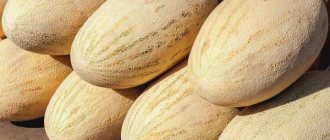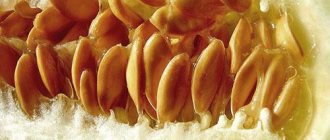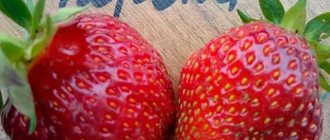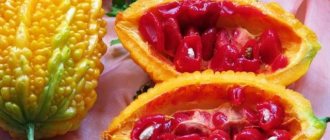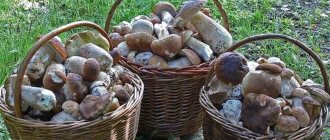Juicy, sweet, aromatic melon, loved by many, is an incredibly popular agricultural crop. The benefits of melon have been known since ancient times. This plant, which now has a huge variety of different varieties, contains a record amount of vitamins and microelements necessary for humans. This fruit was and is especially revered in the East. After all, its composition is capable of replacing many food products. Often during particularly hot days and religious fasts, residents of the eastern regions eat only melons.
Understand the question “is melon a fruit or a berry? “It’s not as simple as it might seem at first glance. The melon fruit initially, before people began to cultivate it, was small in size, about the size of a plum.
It grows on the ground, has juicy pulp and seeds inside, which means it’s a berry? It has a very sweet taste, it is definitely a plant dessert, which means it is a fruit? The melon culture belongs to the pumpkin family, which means it is a vegetable? These questions still do not have a clear answer. Scientists still tend to classify this plant as a dessert vegetable.
Botanical description
One way or another, the final decision on the question “melon is a vegetable, berry or fruit” remains on the conscience of botanists. Melon belongs to the genus of pumpkins, the cucumber family, and is an annual herbaceous plant with a creeping stem from 2 to 4 meters in length. The plant has a very strong, long and branched root system, capable of drawing water well from the soil and retaining it for a long time. Only fertile soil and a hot sunny climate are suitable for planting. Therefore, the birthplace of this culture is North Africa and north-west India.
The size of the fruit varies depending on the variety from 200 g. up to 20 kg. From 2 to 7 fruits can ripen on one plant. The shapes of the fruits are also very diverse - round and oblong, long, straight and serpentine, up to 1.5 m, the so-called “Armenian cucumbers”.
The peel can be smooth or rough, green, yellow, orange, uniform in color, striped or spotted. The pulp of the melon is sometimes of a delicate consistency, sometimes hard, like that of an apple. The taste ranges from neutral to sickly sweet, the aroma smells of vanilla, pineapple, honey or pear, depending on the plant variety.
Meet the yellow beauty
You can understand what a melon (Cucumis melo) is by studying its closest “relatives”. The culture belongs to the melon family and is part of the extensive pumpkin family. Melon is a separate species belonging to the genus Cucumber. Close relatives of this biological species are pumpkins, cucumbers, zucchini, as well as the more exotic kiwano and loofah. Therefore, the question whether a melon is a berry or a fruit is incorrect. The crop should be classified as a vegetable.
The note! Kiwano, which tastes like a cross between a banana and a cucumber, is called the “horned melon.” The fruits of this herbaceous plant from the pumpkin family are covered with pimples. Despite its tropical origin, the crop can be grown in warm regions.
There is a widespread belief among culinary specialists that melon is a fruit because it has sweet pulp. But it is worth noting that the term “fruit” is of an everyday nature. This is the common name for all sweet fruits of trees or shrubs. But melons are herbaceous plants, like berries. At the same time, only those that can be taken with two fingers and eaten whole at a time can be considered the last. The size of the pumpkin does not allow this.
The multi-seeded, berry-like fruits of all plants in the pumpkin family are called “pumpkins.” But in reality, they can be considered false berries, since from a botanical point of view, only multi-seeded fruits covered with a thin shell rather than a dense peel can be classified as berries.
Chemical composition and calorie content
90% of melon consists of water. There are no fats in it, but there is a large amount of carbohydrates - 7.5 g. per 100 gr. product. Melon has very little protein - only 1 gram, so for those who are on a diet, this product can be a great help in losing weight.
The calorie content of melon is only 36 Kcal per 100 grams.
Melon contains almost all vitamins, as well as many macro and microelements, acids and amino acids:
- Glucose fills the body with energy and gives joy to sweet lovers.
- Amino acids contribute to the production of joy hormones.
- Vitamin C forms stable immunity to various diseases and maintains tone.
- Retinol is essential for maintaining good vision and eye health.
- B vitamins are necessary to maintain good muscle tone and regulate digestion.
- Tocopherol is a natural antioxidant that removes harmful radicals from the body, helps strengthen the immune system, and has a beneficial effect on the nervous system.
- Nicotinic acid reduces the level of bad cholesterol, prevents the formation of blood clots, and improves cerebral circulation.
- Folic acid is essential for women during pregnancy.
- Iodine is indispensable for the normal functioning of the thyroid gland and for improving memory.
- Calcium is necessary to strengthen the skeletal system, teeth, nails and hair.
- Zinc has great benefits for the male body and improves potency.
- Iron plays an important role in the process of hematopoiesis.
- Phosphorus is essential for good brain function and for improving bone tissue.
- Potassium is important for normal heart and muscle function.
- Silicon is necessary for hair, nails, teeth, nervous system, and brain activity.
- Pectins and dietary fiber are important for good intestinal motility.
- Water quenches thirst and replenishes the body's need for fluid.
Benefits and harms
Of course, melon is a useful product, since only 100 g of fruit produces a lot of various vitamins, minerals, acids and other elements.
Calories:
- 33 kcal;
- proteins – 0.6 g;
- fats – 0.3 g;
- carbohydrates – 7.4 g;
- water – 90 g.
Vitamins:
- Group B - from 0.4 mg to 7.6 mg.
- Vitamin A – 67 mcg;
- Vitamin C – 20 mg;
- Vitamin E – 0.1 mg;
- Vitamin bata Carotene and niacin – 0.4 mg;
- Macroelements (Potassium, Calcium, Magnesium, Sulfur, Phosphorus, Chlorine) – from 10 mg to 118 mg;
- Microelements (Aluminium, Iron, Iodine, Fluorine, Zinc) – from 2 mcg to 1 mg.
Useful and medicinal properties of melon
The benefits of melon for the human body are great. Eating this fruit in reasonable quantities helps improve health:
- The functioning of the cardiovascular system improves, the walls of capillaries are strengthened due to the presence of potassium, magnesium and calcium.
- The body's defenses are increased and the immune system is strengthened due to the high content of vitamin C.
- The iodine contained in the fruit helps in the treatment of thyroid diseases.
- Due to the presence of iron, doctors recommend consuming melon for patients with anemia.
- Fiber, contained in large quantities in melon, improves digestion, removes toxins from the body and reduces the percentage of bad cholesterol.
- Melon pulp has a diuretic effect, so it is recommended to use it to reduce tissue swelling.
- This fruit is also irreplaceable in cosmetology. Carotene and vitamin A contained in the pulp perfectly nourish and moisturize the skin. Masks and creams with melon extracts have an anti-inflammatory and rejuvenating effect. The aroma of this wonderful plant is actively used in perfumery.
The benefits of melon for women
- Melon juice has a rejuvenating effect; it is enough to wipe your face with a frozen slice of melon once a day during the season to soon see the result - smoothed and refreshed skin. The appearance of skin, hair and nails improves due to the presence of silicon in the fruit pulp.
- Eating fresh melon increases libido in both women and men. Reduces fatigue and normalizes the nervous system.
- During PMS, a few slices of the sweet fruit reduce blood pressure, normalize sugar levels, and improve mood.
- Due to its folic acid content, doctors recommend consuming this fruit during pregnancy and menopause.
- For nursing mothers, eating melon increases the volume and fat content of milk.
- Mild laxative properties and low calorie content of melon promote weight loss for those who want to lose weight.
Features of use in a special position
Although melon is not an exotic “fruit,” pregnant women should eat it with caution, as it can cause allergies in the mother or unborn baby.
Breastfeeding women should also not overuse sweet fruits, since the product can cause increased fermentation in the intestines. If the pulp is included in baby food, you should not give it to a baby suffering from colic.
During pregnancy
Expectant mothers should definitely diversify their diet with this product. The pulp has the following beneficial properties:
- Increases hemoglobin, necessary for the normal supply of oxygen to the fetus.
- Removes excess fluid from the body, which helps reduce swelling.
- Improves intestinal motility, eliminates constipation.
- Removes toxins.
Doctors do not advise eating melon in the 1st and 3rd trimester of pregnancy, as it may harm the unborn child. In the early stages there is a risk of miscarriage, and in the later stages there is a risk of premature birth, since the fruit increases the tone of the myometrium.
When breastfeeding
During lactation, doctors advise eating pumpkin subject to a number of conditions:
- A small portion is eaten in the morning, this is necessary to find out how the baby will react to feeding afterwards.
- You should not eat melon in combination with other foods. It replaces a full meal.
- Excessive consumption of pulp is unacceptable, as it will harm the body.
- It is recommended to eat only ripe fruits. You need to buy them during the ripening season, and it is better to refuse imported crops. In winter, the juicy pulp will be replaced by candied fruits.
Contraindications for eating melon
Despite such a lot of beneficial properties of this plant, there are also contraindications to its use:
- It is undesirable to consume the fruit for patients with diabetes.
- The harm of melon will be noticeable when eating it in unreasonable quantities: diarrhea, bloating, flatulence.
- If you have diseases of the gastrointestinal tract, the use of this product is prohibited.
- This fruit should not be eaten with other foods. It is advisable to eat melon an hour before meals or an hour after, and do not wash it down with any liquid.
- If you unwisely eat this fruit, which is rich in vitamins, hypervitaminosis may develop.
- It is also prohibited to use melon if you have kidney and bladder diseases. The diuretic properties of the fetus can provoke the movement of stones and sand.
Caring for seedlings in open ground
When the plantings in the beds delight the eye with their equally even green rows, and the sprouts that have risen from the seeds are no longer inferior to strong home seedlings, it is worth thinking about further care.
One more pinching of the main stem and two side stems at the level of the 2nd pair of leaves is definitely necessary. This is necessary so that the melon vine is not wasted on increasing the green mass, but strives to quickly fill its fruits with juice.
Before pinching again, check the varietal characteristics of your melon - some varieties produce female flowers only on the main stem, which means that it cannot be pinched again!
Now is the time to stop loosening the plantings and hilling them up. We loosen to a depth of no more than 5-7 cm once a week. We combine loosening with hilling.
After the overgrown foliage closes and the root area becomes invisible underneath, we stop both loosening and hilling.
2 weeks after the seedlings take root and sprout from the seeds in the beds, the plants need to be fed: 2 liters. for each bush of ammonium nitrate solution (20g/10l of water).
With the beginning of melon budding, we repeat fertilizing with saltpeter or mullein infusion (1 to 10).
After flowering ends, feed for the last time:
- superphosphate – 50g;
- potassium salt – 20g;
- ammonium sulfate – 30g;
- water – 10 l.
Despite the fact that Cucumis melo is a child of arid steppes, it still needs watering.
Most likely, not even by watering, but by moderately moistening the soil under a ripening bush no more than once every 7-9 days. Of course, with warm water (+23*) and so that the water does not get on the leaves and stem of the plant.
Very good - a groove around the bush. Ideal - drip irrigation.
To maintain the health of melon plantings, do not be lazy in removing weeds and vegetation debris from the beds.
Maintain the rules of crop rotation - two. Do not plant melon in the same place for more than 2 years in a row! Returning to the same place is permissible only after 5 years.
Once a season, for preventive purposes, treat the bushes in cloudy weather with a solution of 50 g of colloidal sulfur per 10 liters of water no later than 20 days before harvesting.
If there are signs of illness, do this twice or thrice with an interval of 7-8 days.
Monitor the condition of your berry plants! Diseases such as Powdery Mildew and Anthracnose in 70 cases out of 100 begin with berry bushes. What can we say about aphids, spider mites and wireworms!
When the first ovaries appear, we wait to select the largest and most beautiful ones. Having selected 2-3 on each of the 3 lashes, we remove the rest, and place the selected ones in a net or string bag (without tearing them off, of course!) and hang the nets on supports - to ripen with tight pulp, fill with sweet juice.
To make the juice even sweeter, reduce watering until it is completely canceled as the color of the fruit skin changes during the ripening period.
If the melon has become so ripe that the support cannot support its weight, place the fruit on a piece of roofing felt to prevent the barrel from rotting.
Dried melon
Dried melon is a fairly popular dried fruit, which is prepared from fresh melon pulp by drying.
The calorie content of dried melon is 341 kcal per 100 g.
Those who want to lose weight should consume this dried fruit with extreme caution. It contains all the same vitamins and microelements as raw melon. Therefore, the benefits and harms are the same as those of the raw fruit, with the exception of the water content, which evaporates during drying.
In addition to the above benefits, dried pumpkin helps to maintain your tan longer due to the presence of vitamin A in it. Dried melon also has a choleretic effect and cleanses the liver of toxins.
Melon: the most popular types
Depending on the color of the peel, taste, size and shape of the fruit, different varieties of melon are distinguished.
Cantaloupe
The pulp of this variety is very tasty and contains many nutrients. You can recognize this variety by the spherical shape of the fruit and orange pulp. The peel of such fruits is usually ribbed and gray-brown. Average melons weigh about 1 kg, although some can reach 5 kilos. A 100-gram serving of pulp contains approximately 34 kilocalories, as well as rich reserves of magnesium, potassium, copper, folic acid, and B vitamins.
Galia
This popular sweet melon variety was developed in Israel. It is characterized by bright flesh, a yellow-brown crust, as if covered with foil. The shape of the fruit is oval. It is an excellent source of vitamins C and A, pectin and antioxidants. A 100-gram slice of this sweet contains approximately 38 kilocalories.
Cassaba (Winter Melon)
The fruit of this variety can be recognized by its round shape and smooth yellow skin, sometimes covered with a mesh pattern. The pulp of the ripe fruit is white and sweet, however, it contains few calories (28 kcal per 100 g of product). These melons do not hold the record for vitamin C or A, but they are excellent sources of vitamin B6, magnesium, potassium and copper. Unlike other varieties, this type of melon is less aromatic and crunchy.
Sugar
Sweet and aromatic pulp, an oval-shaped fruit with a smooth yellowish to greenish skin is a sugar melon. The pulp of the fruit is cream or pale green. Average weight – from 1.8 to 3.6 kg. Calorie content – about 36 kcal per 100 g of fruit. This variety of melon is sweeter than many others and for this reason many people find it tastier. But in terms of useful components, it is somewhat inferior to other varieties, although it still belongs to good sources of vitamins and minerals, especially when it comes to potassium, vitamin B6 and folic acid.
How to choose the right melon
- A thick stem is an indicator of ripeness. Press the peel against the stem. If it is soft, then the fruit is ripe.
- When tapped, a ripe fruit makes a ringing sound, while an unripe fruit makes a dull sound. There should be no scratches, cracks, rotten spots on the surface of the skin, and the fruit should not be cut.
- The aroma of the ripe fruit is very strong and pleasant.
- You need to buy melons from mid-August to mid-September, then there is the greatest chance that they were grown in open ground without chemicals.
And in conclusion, it must be emphasized that melon is a unique product in its composition, both raw and dried. But you need to eat it in moderation (several slices a day), taking into account contraindications and recommendations, and then the benefits of melon will be clearly noticeable.
Description and characteristics of the fruit
Common melon, belonging to the species of the same name, blooms in June-July with bisexual flowers that are pollinated by insects. The fruits ripen from August to September - these are pumpkins with a leathery exocarp, juicy mesocarp and endocarp. They come in different colors and shapes, the color of the flesh is usually white or greenish. The sweet pulp is eaten raw, and candied fruits, honey and jam are also made from it.
Find out why, from a botanical point of view, a watermelon is a berry, but a melon is not.
The eastern lands are considered the homeland of melon - Central and Asia Minor, northern India and nearby areas of Iran. It is assumed that it was cultivated before the beginning of our era. It was brought to the territory of modern Russia only in the 15th–16th centuries.
"Fruit and berry question"
Melon is a foreigner that came from hot Asian countries . In the folk traditions of the cultures of Central and Asia Minor, it is given a place of honor: celebrations are held in its honor, it is widely represented in folklore and local cuisine.
Its cultivation in these regions took centuries, because initially it was a very mediocre plant that did not make anyone want to eat it. However, thanks to long-term selection work to improve its taste, people have the opportunity to enjoy the unique taste.
Characteristic
It is not surprising that melon is considered a fruit . It is either round or oval in shape (though there are also serpentine ones, but this is very rare). The color of its peel is the most “fruity” - from bright yellow to brown-green. Large melon specimens weigh 15-18 kg. Whatever one may say, the fruits are bright, sweet and aromatic. Why not a fruit? And indeed, if we consider that fruits are juicy, sweet fruits of plants, melon undoubtedly belongs to them.
This is interesting. An Australian farmer managed to raise a record-breaking beauty weighing 200 kg in 2009.
On the other hand, it belongs to the annual herbaceous species, the stems of which spread along the ground, finding acceptable support with their tendrils , and the juicy pulp contains many seeds, just like a berry, for example, a gooseberry or a strawberry. Some varieties of melons have strongly pronounced lobar stripes and are somewhat reminiscent of gooseberries. So what does melon belong to? In fact, everything is much more interesting.
Melon to cucumber comrade?
Not just a comrade. According to all botanical characteristics, melon is a close relative of cucumber , and together they are from the pumpkin family. The signs of nepotism are obvious.
In melon, like cucumber:
- long stem-liana with large leaves and tendrils;
- similar leaf shape;
- the shape and color of the flowers are similar: on one melon stem there can be both male (pistillate) and female (staminate) yellow flowers;
- the roots are long, branched and strong;
- the pulp contains many oblong seeds.
Important to remember . Melon is a melon crop, a species of the cucumber genus, in the pumpkin family. The melon fruit is called pumpkin.
That is, from a botanical point of view, a melon can quite rightly be called a vegetable , as they call it, for example, a pumpkin.
Problems encountered when growing melons
Sometimes inexperienced gardeners fail when growing melons. But there is nothing irreparable.
Table: problems and their solutions
| Problem | How to fix it |
| The melon produces only male flowers and empty flowers. | The melon must be pinched above the 4-5th leaf. Female flowers are formed on the emerging side vines. |
| The melon blooms, but there is no ovary | This often happens when growing melons in greenhouses. Pollinating insects rarely fly there. Therefore, flowers need to be pollinated manually. |
| The plant's leaves are turning yellow | This can happen for several reasons:
Carefully inspect the plants and eliminate any errors. |
| Spots appeared on melon leaves |
|
| The fruits are cracking | When the fruits ripen, stop fertilizing and moistening the plants. |
| Fruits rot in the garden |
|
When the melon begins to ripen, stop watering and fertilizing, otherwise the fruit may crack.
Varieties and varieties
Currently, there are many different forms and subspecies of this plant, bred and cultivated in individual regions. These include:
Cantaloupe is a subspecies of crop characterized by striped skin. The fruits grow up to 25 cm in length and have orange flesh. One day they were presented as a dessert to the Pope, who then gave the seeds to be grown on his estate in Cantaloupe. So these melons came to be called cantaloupes. These days, this form of plant is grown in almost every corner of the world.
- Serpentine melon, or Armenian cucumber, is a melon crop with elongated fruits that can grow up to 50 cm in length. Unripe fruits, like cucumbers, are most often eaten.
- Winter melon, or wax gourd, is a herbaceous vine belonging to the genus Benincasa. As the fruit ripens, it becomes covered with a waxy coating, thanks to which it can be stored for quite a long time. This species is grown mainly for its large fruits, which can grow up to 2 m in length.
- Pineapple is an early ripening variety that ripens in 60-75 days, which makes it possible to grow it even in the non-black earth zone. It is distinguished by the skin of the fruit, which is streaked with a network of cracks. The maximum weight of a mature fruit can reach 2 kg.
It is worth noting other varieties of this plant: Gulyabi, Torpedo, Kassaba, etc.
Vegetable, fruit or berry?
No matter how interesting the melon’s travels across continents are, this does not answer the question that interests many: what is the correct name for the crop: a fruit or a vegetable. We should start by saying that there is a significant difference between the culinary and botanical definitions of many plants. So, for example, we are used to saying “fruit” about all sweet fruits, and “vegetable” about any unsweetened part of the plant. That is, given that melon is sweet and is usually consumed as a dessert, from a culinary point of view, it is a fruit.
In biology and botany everything is different. A vegetable is the leafy part of a plant (such as spinach), roots (such as carrots), stems (such as ginger) or flower buds (such as cauliflower).
According to BES, a vegetable is also called a fruit, meaning those parts of the plant that are formed from the flower and serve as a storage for seeds. Dry fruits include: leaf, bean, pod, box, nut, grain. For juicy ones: berry, apple, pumpkin, drupe. Expanding this definition, a vegetable is the succulent part of herbaceous plants that are eaten, such as shoots, roots, tubers, rhizomes, inflorescences, leaves, heads of cabbage, bulbs. Since the fruit of the melon is a pumpkin, from a botanical point of view it is a vegetable.
The confusion arises from the fact that “fruit”, as a definition, is used interchangeably with fruit. Fruit - An edible fruit from a tree or shrub, usually an angiosperm, but also produced from an ovary.
The following species variations of the large “fruit” group are divided:
- with juicy pulp and seeds - orange, melon, apple, cucumber;
- with juicy pulp and large seeds - cherries, peaches, plums;
- dry fruits - nuts, beans, peas.
Therefore, melon fits both categories at the same time, being both a fruit and a vegetable. At least, why argue with botany?
FROM THE HISTORY OF MELOON
Ancient Egypt and northern India are considered the birthplace of melon. Judging by ancient frescoes dating back to the 3rd century BC, it was the most delicious fruit that was served to the table of the ancient pharaohs and high nobility.
At the beginning of the new era, melon “migrated” to China, Central Asia and the Middle East. But there is evidence that at the same time it was also known in Africa.
Here it was widely cultivated in melon fields by ancient tribes. More than a dozen different varieties of melon grew on the African continent. Most of them were distinguished by their hard bark, from which they made dishes for dry sweets, since the delicate melon aroma of its bark complemented their unusual taste.
Melon came to Europe in the Middle Ages and immediately spread widely throughout Western Europe. At first it was grown in the gardens of the highest nobility and served only on major holidays, but then it quietly migrated to the gardens of ordinary people.
Melon seeds were very expensive, but there were so many of them in each fruit that some, thrown into the trash, were simply given to the peasants for free.
The first samples of various cultivated varieties of melon were brought to our country in the late twenties of the last century. It was with them that breeding work began on the creation of domestic varieties of this wonderful crop in several scientific institutions located in different regions of the country.
By the beginning of the 50s, melon was grown in all southern regions and regions of the Soviet Union. At the end of the 90s, work began on creating frost-resistant melon varieties for the northern regions of Russia.
Melon ripening season and storage conditions
From a distance it looks like the melons are just lying on the ground!
Since childhood, I remember this agonizing wait, when melons were already being sold everywhere in huge quantities, the aroma was dizzying from these yellow mountains, and my mother and father walked my brother and me past, saying that it was too early to eat them, that we needed to wait for August. Perhaps this was one of my main lessons in patience.
